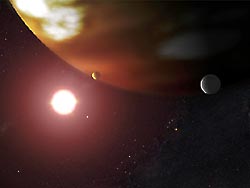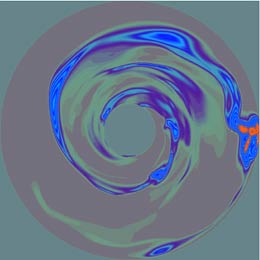
An artist's conception of the outer giant planet orbiting the red-dwarf star Gliese 876. The inner planet is the tiny dot close to the star. Though redder and dimmer than the Sun, red dwarfs still have temperatures and surface brightnesses great enough to make them appear as dazzlingly white as a light-bulb filament to anyone seeing them up close — as the artist has correctly shown. Red dwarfs comprise over 80 percent of our galaxy's stars, and most of them do not have stellar companions.
Artwork courtesy NASA and G. Bacon (STScI).
Astronomers have known since the 1700s that a significant fraction of stars belong to binary or multiple systems. But what is that fraction? Given the observed fact that most solar-size and larger stars reside in binaries, many astronomers have concluded that more than half of our galaxy's stars belong to multiple-star systems.
But a new study by Charles Lada (Harvard-Smithsonian Center for Astrophysics) shows that conventional wisdom is almost certainly wrong. The problem, says Lada, is that astronomers have neglected to consider our galaxy's most common stellar denizens: red dwarfs (spectral type M). These low-mass, low-luminosity stars make up more than 70 percent of all the stars in the Milky Way.
Lada cites surveys from groups led by Geoff Marcy (University of California, Berkeley), Neil Reid (Space Telescope Science Institute), Xavier Delfosse (Astrophysical Laboratory of Grenoble, France), and others that find that the single-star fraction among red dwarfs is very high. And because red dwarfs are the dominant population of stars, single stars must account for upwards of two-thirds of all stellar systems in the galaxy Lada concludes in his paper, which has been submitted to Astrophysical Journal Letters.
"By assembling these pieces of the puzzle, the picture that emerged was the complete opposite of what most astronomers have believed," says Lada.
These results are consistent with the findings of the ongoing RECONS study at Georgia State University, which surveys the Sun's local neighborhood. The RECONS study has found that only 43 of the 171 primary red dwarfs within 10 parsecs (32.6 light-years) of the Sun have either another red dwarf or brown dwarf as a companion. "This is a lower limit, of course, because we're still uncovering companions," says RECONS team leader Todd Henry. "But we've known that the binary fraction of red dwarfs is much lower than the fraction for more massive stars."
Studies like these have important ramifications for theories of star and planet formation, since planets probably have an easier time forming around single stars than they do in binary systems. In fact, a low-mass planet was announced earlier this week around a solitary red dwarf.

This computer simulation shows a protoplanetary disk around one member of a binary-star system. Jupiter-mass clumps of gas (red and blue regions) form easily and later collapse to form gas-giant planets.
Courtesy Alan Boss.
But the news isn't all bad for binary-star planets. At the American Astronomical Society meeting earlier this month, Henry and his Georgia State colleague Deepak Raghavan found that 29 of 131 stars known to host at least one exoplanet also have a stellar companion. Theoretical models by Alan Boss (Carnegie Institution of Washington) suggest that a distant stellar companion's gravity can actually induce planet birth around a star by triggering the coalescence of dense gas clumps within a protoplanetary disk. The clumps quickly collapse to form gas-giant planets. Jack Lissauer (NASA/Ames Research Center) presented his group's findings that Earth-size planets can form in wide orbits around two stars in a tight binary and in close orbits around one of the two stars in a widely separated binary.
"The take-home message is that half of all wide binary-star systems can harbor planets because the separation is great enough to permit both the formation and the subsequent stability of the resulting planetary orbits," says Marcy, coleader of the team that has discovered more than half of the 170-plus known exoplanets. "There are surely tens of billions of Sun-like stars in the galaxy that can easily harbor planets."
 0
0
Comments
You must be logged in to post a comment.